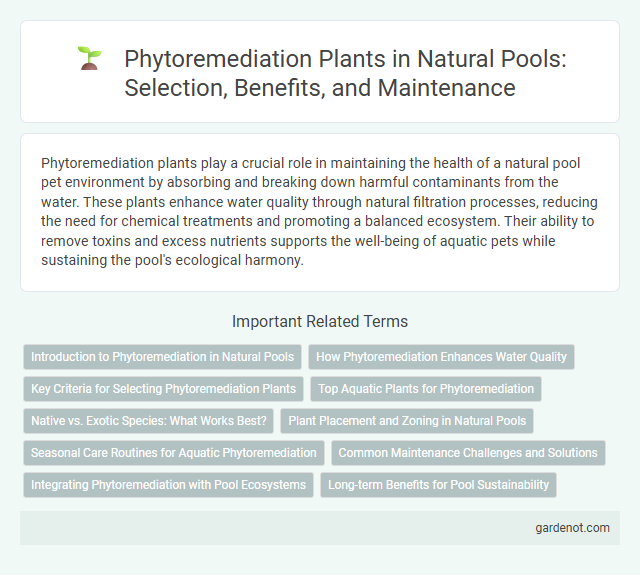Phytoremediation plants play a crucial role in maintaining the health of a natural pool pet environment by absorbing and breaking down harmful contaminants from the water. These plants enhance water quality through natural filtration processes, reducing the need for chemical treatments and promoting a balanced ecosystem. Their ability to remove toxins and excess nutrients supports the well-being of aquatic pets while sustaining the pool's ecological harmony.
Introduction to Phytoremediation in Natural Pools
Phytoremediation in natural pools utilizes specific aquatic plants such as water hyacinth, cattails, and bulrushes to naturally filter and detoxify contaminants through processes like uptake, degradation, and stabilization. These plants enhance water quality by absorbing heavy metals, nutrients, and organic pollutants, promoting a balanced aquatic ecosystem without the need for chemical treatments. Integrating phytoremediation plants supports biodiversity and creates sustainable, self-cleaning environments within natural swimming pools.
How Phytoremediation Enhances Water Quality
Phytoremediation plants improve water quality in natural pools by absorbing and breaking down pollutants such as heavy metals, nitrates, and organic compounds through their root systems. These aquatic plants enhance oxygen levels and promote beneficial microbial activity, which further degrades contaminants and prevents algae overgrowth. By maintaining a balanced ecosystem, phytoremediation plants reduce the need for chemical treatments and support sustainable water purification.
Key Criteria for Selecting Phytoremediation Plants
Selecting phytoremediation plants for natural pools requires evaluating factors such as pollutant tolerance, root system structure, and growth rate to ensure effective contaminant removal. Plants with extensive root systems and high biomass production enhance nutrient uptake and stabilize substrates, promoting water clarity and ecosystem balance. Native species adapted to local conditions increase resilience and reduce maintenance, supporting sustainable phytoremediation in natural pool environments.
Top Aquatic Plants for Phytoremediation
Top aquatic plants for phytoremediation in natural pools include water hyacinth (Eichhornia crassipes), duckweed (Lemna minor), and cattails (Typha latifolia) due to their exceptional ability to absorb heavy metals and excess nutrients. These plants improve water quality by removing pollutants like nitrogen, phosphorus, and organic compounds through their extensive root systems. Incorporating these species enhances the ecological balance of natural pools by promoting cleaner, healthier water environments.
Native vs. Exotic Species: What Works Best?
Native phytoremediation plants in natural pools provide optimal water purification by efficiently removing pollutants while maintaining local biodiversity. Exotic species may offer rapid growth but often disrupt ecosystem balance and require more maintenance, leading to potential ecological risks. Research shows native species such as cattails (Typha spp.) and bulrushes (Schoenoplectus spp.) outperform exotic alternatives in sustainability and effectiveness for phytoremediation.
Plant Placement and Zoning in Natural Pools
Phytoremediation plants in natural pools should be strategically placed based on water flow and nutrient distribution to maximize contaminant uptake and enhance water purification. Tiered zoning with emergent plants in shallow edges, floating plants in mid-water areas, and submerged plants in deeper zones creates optimal conditions for filtration and habitat diversity. Careful spatial arrangement facilitates efficient nutrient cycling and supports a balanced aquatic ecosystem in the pool.
Seasonal Care Routines for Aquatic Phytoremediation
Seasonal care routines for aquatic phytoremediation plants in natural pools involve regular pruning during spring to promote new growth and prevent overcrowding. In summer, maintaining optimal water levels and removing decaying plant matter helps maximize contaminant absorption and oxygenation. Autumn care includes trimming back dying foliage and preparing plants for dormancy, ensuring their health and effectiveness for the following season.
Common Maintenance Challenges and Solutions
Phytoremediation plants in natural pools often face common maintenance challenges such as nutrient imbalance, algae overgrowth, and root system clogging. Regular monitoring of water quality and strategic plant pruning can help maintain optimal nutrient absorption and prevent excessive algae proliferation. Implementing a diverse selection of aquatic plants enhances system resilience, promoting balanced ecosystems and reducing maintenance frequency.
Integrating Phytoremediation with Pool Ecosystems
Phytoremediation plants, such as water hyacinth (Eichhornia crassipes) and cattails (Typha spp.), play a crucial role in natural pools by absorbing harmful nutrients and heavy metals, effectively improving water quality and reducing algae growth. Integrating these plants into pool ecosystems creates a balanced environment where microbial activity and plant uptake work synergistically for biofiltration. This sustainable approach enhances biodiversity, promotes oxygenation, and minimizes the need for chemical treatments in natural swimming pools.
Long-term Benefits for Pool Sustainability
Phytoremediation plants in natural pools enhance water quality by absorbing and breaking down pollutants, reducing the need for chemical treatments. Species such as water hyacinth and cattails promote nutrient cycling and oxygenation, supporting balanced ecosystems over time. The long-term use of these plants fosters sustainable pool maintenance, lowering operational costs and minimizing environmental impact.
Phytoremediation plant Infographic

 gardenot.com
gardenot.com